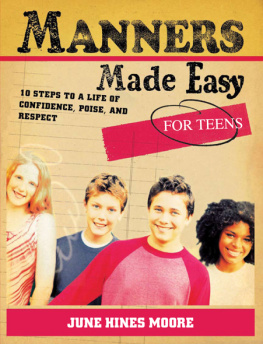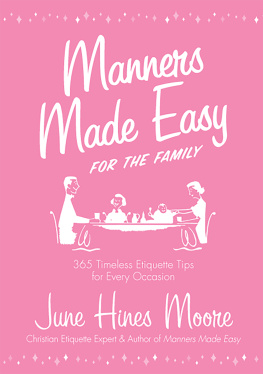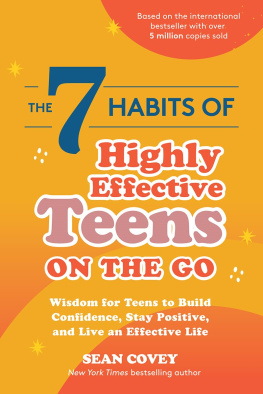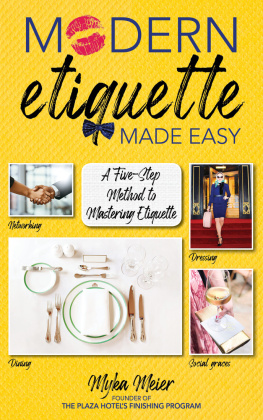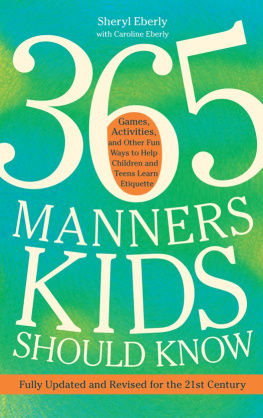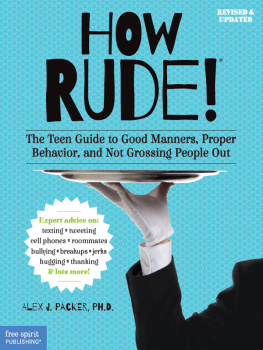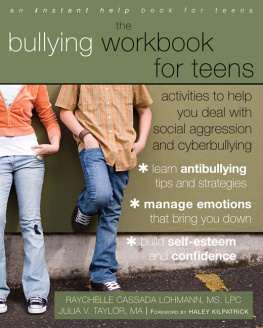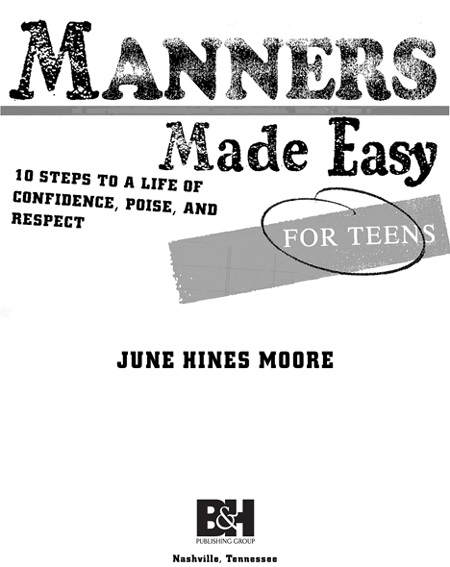HOW TO USE THIS BOOK
Dear Reader,
You may be the most well-mannered teen in your community, or you may see no conceivable reason to learn a bunch of rules your great-grandparents thought were important. Either way, this workbook can be fun and extremely useful to you. In these pages you will find helpful advice that can make a difference in your life right now and in the years to come.
Manners were God's idea, and He kept it very simple for us. All manners are based on the Golden Rule, which basically says, Do for others what you would like them to do for you. Even the Wall Street Journal quotes that rule as the basis for all business and social interaction. This simple rule allows us to put other people at ease, feel good about ourselves and what we do, and leave awkwardness and fear behind.
Now, you may come from a home where good manners and the Golden Rule are taught and practiced daily, but your parents know that our society seems to have forgotten the need for proper manners, etiquette, and decorum. Relationships have been irreparably damaged, and many promotions in business and even jobs have been lost as a result.
It doesn't have to be this way.
Etiquette is really nothing more than a code of proper behavior that greases the squeaks in our contact with people. Knowing the basic rules of etiquette will provide you with the tools you need to:
- impress college admissions officers
- succeed in a job interview
- obtain the admiration of the opposite sex
- earn compliments, respect, and recognition
- turn self-consciousness into self-confidence
Of course, it's one thing to read a book about making small talk in an awkward situation, going on your first job interview, or what to do when your cell phone rings in church. It's quite another thing to live through the experience. Making a faux pas (a French phrase meaning mistake) while we are eating at home with the family may not be terribly painful, but what about when we make an embarrassing mistake while dining with a friend's family or while on a date?
If you fear doing or saying the wrong thing, it's simply because you don't know the rules. With the training you receive in this manual, you will have every reason to be more confident and less self-conscious in public. Everyone has social skills, good or bad, but you will know the rules and how to put them into practice. You will learn how to focus on others and not so much on yourself. New doors of opportunity, success, and enjoyment will open up for you, and wisdom you gain here will serve you all the days of your life.
You can read this book on your own, but ideally you will work with a parent or teacher to learn and practice the skills taught herein. Each lesson includes at least one exercise or role-playing scenario that will help you turn a simple list of rules into life-changing habits. Have fun while learning and practicing these rules: They are your friends.
Think of it this way. You wouldn't risk ridicule and injury by playing an organized sport without knowing the rules or having the proper equipment. And you would not think of performing in a stage play before a large audience without knowing your lines or having some training in the theater. No matter what you choose to do with your life, there will be many crucial moments when you find yourself in the spotlight, when it seems that everyone is suddenly watching everything you say and do. Will you shine or stumble? If you will practice and prepare for these moments, etiquette can make the difference.
Remember, as you participate in the exercises in this book, do not correct the etiquette of others. Correcting other people's manners is rude and only embarrasses them. Only critique another's manners if that person or your teacher asks you to make suggestions.
With the rules of etiquette in your head and the Golden Rule in your heart, you will not embarrass yourself or others. With new confidence in your social skills, you can focus on getting to really know people and experiencing good times together. You won't have to be self-conscious, living in constant fear of making a mistake or saying the wrong thing and being ridiculed for it.
As the author, I pray God's blessing on your efforts to grow in wisdom and stature, and in favor with God and man (Luke 2:52).
Enjoy!


LESSON ONE
MAKING A GOOD (FIRST AND LAST) IMPRESSION
Learning Objective
To develop confidence in your relationships and daily interaction with others. In this chapter, you will learn to use the six S's and proper body language to make a lasting good impression on the people you meet and spend time with.
Introduction
Most of us want to make a good impression. Researchers tell us that it takes only a few seconds to make a first impression, but it takes several additional interactions to change someone's bad impression of us. In this lesson, you will discover a successful way to make a good first and lasting impression every time by learning how to present yourself properly to others.
IT TAKES AS LITTLE AS FIFTEEN SECONDS TO MAKE A FIRST IMPRESSION, BUT IT MAY TAKE THE REST OF YOUR LIFE TO CHANGE A BAD ONE.
THE SIX S'S
Every time you meet someone new and even when you greet an old friend, you are making some kind of an impression. To make a favorable impact on others, you need to know and practice the six S's: Stand. Smile. See their eyes. Shake hands. Say your name. Say their name back to them. Whether meeting or greeting, each of these actions make up your calling card, and everyone makes an impressiongood or bad.
When the six S's become a habit, you will be free to focus on the things that are truly important because you will have more confidence in how you present yourself. You will no longer have to be self-conscious or worry about making a good impression. Armed with these skills, you will fulfill one of God's purposes for your lifereaching out to others.
When you learn and practice the six S's, you will unlock one of the secret codes of good manners and personal confidence. Why is it a secret code? Because few people will tell you when you fail to make a good impression. Some things are best learned at home or in class.

